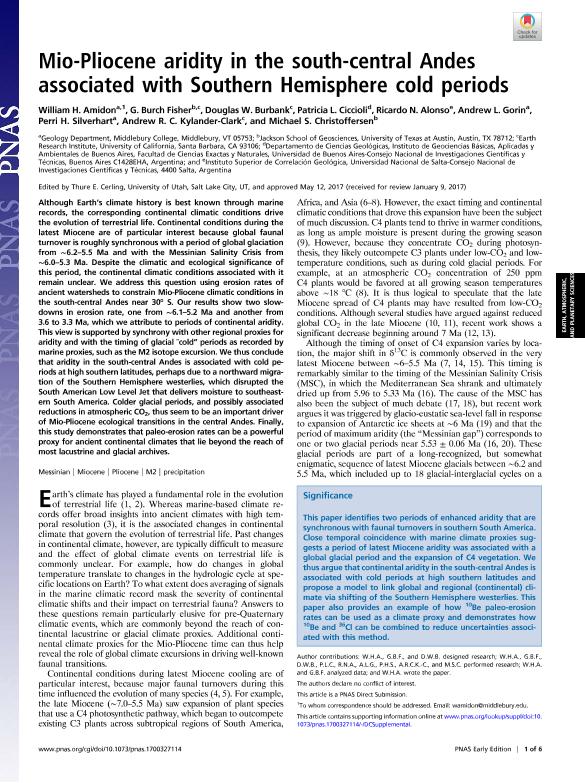Mostrar el registro sencillo del ítem
dc.contributor.author
Amidon, William H.
dc.contributor.author
Fisher, G. Burch
dc.contributor.author
Burbank, Douglas W.
dc.contributor.author
Ciccioli, Patricia Lucia

dc.contributor.author
Alonso, Ricardo Narciso

dc.contributor.author
Gorin, Andrew L.
dc.contributor.author
Silverhart, Perri H.
dc.contributor.author
Kylander Clark, Andrew R.C.
dc.contributor.author
Christoffersen, Michael S.
dc.date.available
2018-12-13T15:31:22Z
dc.date.issued
2017-06
dc.identifier.citation
Amidon, William H.; Fisher, G. Burch; Burbank, Douglas W.; Ciccioli, Patricia Lucia; Alonso, Ricardo Narciso; et al.; Mio-Pliocene aridity in the south-central Andes associated with Southern Hemisphere cold periods; National Academy of Sciences; Proceedings of the National Academy of Sciences of The United States of America; 114; 25; 6-2017; 6475-6479
dc.identifier.issn
0027-8424
dc.identifier.uri
http://hdl.handle.net/11336/66415
dc.description.abstract
Although Earth's climate history is best known through marine records, the corresponding continental climatic conditions drive the evolution of terrestrial life. Continental conditions during the latest Miocene are of particular interest because global faunal turnover is roughly synchronous with a period of global glaciation from 6.2-5.5 Ma and with the Messinian Salinity Crisis from 6.0-5.3 Ma. Despite the climatic and ecological significance of this period, the continental climatic conditions associated with it remain unclear. We address this question using erosion rates of ancient watersheds to constrain Mio-Pliocene climatic conditions in the south-central Andes near 30° S. Our results show two slowdowns in erosion rate, one from 6.1-5.2 Ma and another from 3.6 to 3.3 Ma, which we attribute to periods of continental aridity. This view is supported by synchrony with other regional proxies for aridity and with the timing of glacial "cold" periods as recorded by marine proxies, such as the M2 isotope excursion. We thus conclude that aridity in the south-central Andes is associated with cold periods at high southern latitudes, perhaps due to a northward migration of the Southern Hemisphere westerlies, which disrupted the South American Low Level Jet that delivers moisture to southeastern South America. Colder glacial periods, and possibly associated reductions in atmospheric CO2, thus seem to be an important driver of Mio-Pliocene ecological transitions in the central Andes. Finally, this study demonstrates that paleo-erosion rates can be a powerful proxy for ancient continental climates that lie beyond the reach of most lacustrine and glacial archives.
dc.format
application/pdf
dc.language.iso
eng
dc.publisher
National Academy of Sciences

dc.rights
info:eu-repo/semantics/openAccess
dc.rights.uri
https://creativecommons.org/licenses/by-nc-sa/2.5/ar/
dc.subject
M2
dc.subject
Messinian
dc.subject
Miocene
dc.subject
Pliocene
dc.subject
Precipitation
dc.subject.classification
Meteorología y Ciencias Atmosféricas

dc.subject.classification
Ciencias de la Tierra y relacionadas con el Medio Ambiente

dc.subject.classification
CIENCIAS NATURALES Y EXACTAS

dc.title
Mio-Pliocene aridity in the south-central Andes associated with Southern Hemisphere cold periods
dc.type
info:eu-repo/semantics/article
dc.type
info:ar-repo/semantics/artículo
dc.type
info:eu-repo/semantics/publishedVersion
dc.date.updated
2018-10-23T21:18:48Z
dc.journal.volume
114
dc.journal.number
25
dc.journal.pagination
6475-6479
dc.journal.pais
Estados Unidos

dc.journal.ciudad
Washington
dc.description.fil
Fil: Amidon, William H.. Middlebury College; Estados Unidos
dc.description.fil
Fil: Fisher, G. Burch. University of Texas at Austin; Estados Unidos. University of California; Estados Unidos
dc.description.fil
Fil: Burbank, Douglas W.. University of California; Estados Unidos
dc.description.fil
Fil: Ciccioli, Patricia Lucia. Universidad de Buenos Aires. Facultad de Ciencias Exactas y Naturales. Departamento de Ciencias Geológicas; Argentina. Consejo Nacional de Investigaciones Científicas y Técnicas; Argentina
dc.description.fil
Fil: Alonso, Ricardo Narciso. Consejo Nacional de Investigaciones Científicas y Técnicas. Centro Científico Tecnológico Tucumán. Instituto Superior de Correlación Geológica. Grupo Vinculado al INSUGEO- Centro de Estudios Geologicos Andinos; Argentina
dc.description.fil
Fil: Gorin, Andrew L.. Middlebury College; Estados Unidos
dc.description.fil
Fil: Silverhart, Perri H.. Middlebury College; Estados Unidos
dc.description.fil
Fil: Kylander Clark, Andrew R.C.. University of California; Estados Unidos
dc.description.fil
Fil: Christoffersen, Michael S.. University of Texas at Austin; Estados Unidos
dc.journal.title
Proceedings of the National Academy of Sciences of The United States of America

dc.relation.alternativeid
info:eu-repo/semantics/altIdentifier/doi/https://dx.doi.org/10.1073/pnas.1700327114
dc.relation.alternativeid
info:eu-repo/semantics/altIdentifier/url/https://www.pnas.org/content/114/25/6474
Archivos asociados
